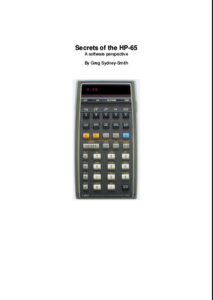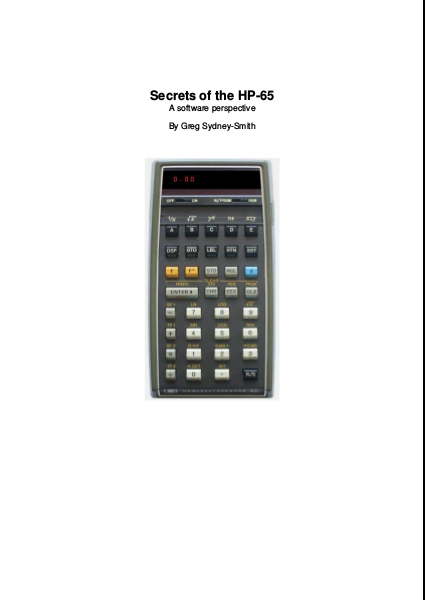
Have you ever wondered how the HP-65 calculator works, what’s in it or what goes through its mind as the display flickers its way through a program? I did.
Now I expect I’m a bit unusual and most people just use their calculators; but if you’re a bit unusual too, this is the book for you.
What’s in It?
The book is over 1300 pages long at present.
It covers:
1 INTRODUCTION
2 MICROCODE
3 COMMON ROUTINES
4 DATA ENTRY
5 ARITHMETIC
6 FUNCTIONS
7 STACK OPERATIONS
8 MEMORIES
9 PROGRAMMING
10 FURTHER READING
Does it Cover Everything?
Mostly. It is a software / microcode perspective so it won’t tell you how often to change the batteries or where to get new ones.
The microcode and register contents for every step of every function in the calculator is included, by individual function. Many common bits are analyzed. The meanings of the flags and register values are identified.
How the prefix keys work is shown.
Why keys and merged keycodes have the internal codes they do is explained.
The flag that everyone overlooks is identified and it shows you what happens when it gets set. (Most emulators never even enter these parts of the microcode).
What’s Missing?
Hardware of course.
The HP-65 calculator’s main claim to fame was its programmability. I have traced, tracked and analyzed every programming aspect of the calculator. The book includes my detailed commentary on every one of those functions.
What’s missing though, for now, is a deep analysis of many of the purely calculator functions. They are listed and you can follow what they do and see how they do it; but my commentary is (mostly) missing in this edition (Edition 0.10).
That will change with time and the “mostly missing” statement is because I have included work that Jacques Laporte did on sine, cos and tan. Much of that translates well to the HP-65 so I have used it as the basis of a deep explanation of how the HP-65 does those functions. I have glossed over some bits that Jacques covered but I have also expanded on other parts that I found difficult to follow. It is my hope that I’ve made those parts clearer.
Plus, minus, times and divide are also well covered.
I will work my way through the rest with time but I’ve been tied up for months getting this much done so I’m getting it released now.
Updates
If this is a work in progress, why should I buy a copy now?
A fair question indeed. Anyone that buys a copy will get all updated editions for 12 months after purchase, for free. I’d rather the information were available now.
What about after 12 months?
If I’m still updating it after 12 months and you’re an existing customer, we’ll work something out.
What / Why Does It Cost?
I said to my daughter, “Out of the billions of people in the world, there are probably only three that will be interested in this book.” It’s a labour of love. It’s never going to make a profit. Those of you that do HP calculator products will already know that – it is too narrow a field, there aren’t any customers. We loved the HP calculators at the time. We still do. But most of the world these days wasn’t there and has other interests.
The book costs $19.95 USD.
If I get my three sales I’ll have made less than $0.50/hour. It doesn’t justify the time spent and it doesn’t compete with my day job but I think it is useful work and I’d like to be able to say some people were willing to cover some of the costs of making it happen.
If you’re one of the three, thank you so much. The different calculators do things differently and having a reference book on one means I don’t have to remember the differences. I really hope you find it equally useful.
Where do I get a copy?
You can get it through PayPal:
Secrets of the HP-65, USD $19.95
Note: This is a digital download of a PDF book; not a physical book.

